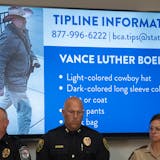North to south, ice fishing ramps up
If early-season ice fishing on Lake Reno is an indication, outdoors lovers aren't tiptoeing back to winter.
Despite reports of inconsistent ice thickness on the Pope County lake, a swarm of anglers jammed two parking lots last weekend and overflowed onto the shoulders of Hwy. 29 to park and cover the ice with augers and other gear. Located 11 miles south of Alexandria, the lake holds sunfish, crappies and state-stocked walleyes.
"Everyone has drilled everywhere and the ice looks like Swiss cheese,'' one fisherman wrote on the Minnesota Ice Fishing Reports Facebook site.
With ice fishing long-established as one of Minnesota's most popular and durable winter activities, it's well underway in the northern tier and spreading quickly to the Mille Lacs area and farther south. Ice fishing and dark house spearing are the reasons why those 2021 fishing licenses are good until March 1, 2022.
This week it was frustrating Max Westerberg, co-founder of the Hard Water Zombies fishing club, not to be with his pals on Lake of the Woods. "They're putting the hammer down,'' he said Wednesday from his home in Isanti County. "I'm on my way up there.'''
Even on the St. Croix River in the east metro area, early birds have been inching out, said fishing guide Darren Troseth, who caught a 120-pound sturgeon through an ice hole in the river in 2019. He'll wait for thicker ice in January.
"The cold snap this weekend will help,'' he said.


